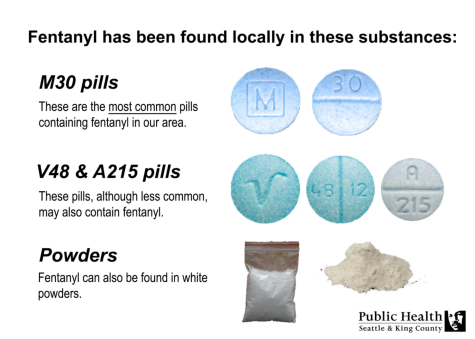Chemical Warfare: America’s Opioid Epidemic
March 13, 2023
The opioid crisis has taken a massive toll on America, lowering life expectancy and taking the lives of thousands of individuals each year. The drug, which correlates with our homeless population numbers, has taken over in overdose and addiction rates. This drug goes by the name of fentanyl, a highly addictive, highly deadly drug.
The epidemic
In its most common form, fentanyl is a light blue pill, hence its common nickname ”blues” (see image below). Fentanyl was introduced in America in the 1960s but overtook the illegal drug market around 2016, most likely due to people using fentanyl-laced meth, heroin, and cocaine. The National Institute on Drug Abuse attributes the reason for lacing to fentanyl’s potency, addictiveness, and its lower price.
Fentanyl is a powerful synthetic opioid similar to morphine but 50 to 100 times more potent, according to the Centers for Disease Control and Prevention. Like other opioids, it is a painkiller that crosses the dura (a membrane of connective tissue that surrounds the brain and spinal cord) and binds to the spinal opioid receptors, according to the National Institute on Drug Abuse.
Johns Hopkins’ other statistics show that “in 2015, more people in the U.S. died from overdose than from firearm homicides, melanoma, auto accidents or HIV-related causes.” Of the 64,000 people who died due to overdose in 2016, fentanyl was responsible for 20,000 of those deaths.
According to Provisional Drug Overdose Data from the CDC, in 2019 New Mexico had the 12th highest overdose rate in the nation, with someone dying from opioid use every 14 hours. In 2022, someone died from an overdose every 11 hours.
How to help one person at a time
If someone is on fentanyl, it will be relatively obvious: Mentally, they’ll seem confused and spacey, happy or euphoric, and drowsy. Physically, their breathing may be shallow or forced (opioids reduce the body’s need for oxygen), and their pupils will be constricted.
Sometimes the first sign that they are overdosing is discoloration in their lips. If this is the case, while they’re responsive, calmly remind them to breathe (fentanyl can cause respiratory depression and respiratory arrest), get them water, and try to engage them or stay with them.
When a user becomes unresponsive, whether moving around or not, they have – or are about to – overdose. When this happens, the best move is to administer NARCAN (Naloxone), a nasal medicine that will flood the opioid receptors, pushing out the opioid already existing in that space. When administered, the person will mostly wake up and be able to respond. The person may throw up, feel intensely cold, and will remain “out of it.” But they will be present. It’s important not to overwhelm the person at this time.
To get NARCAN in New Mexico, you can get it from almost every pharmacy, or call 505-270-5943. To administer it, push the nasal device found within the packaging into one nostril until it’s as far in as it will go. You should have your pointer finger and your middle finger on the holds of the device around the nostril-shaped insertion, and your thumb on the button/plunger on the bottom. Then push the bottom up.
At this point you should call an ambulance if you haven’t already done so. According to A Dose of Reality, you should then continue to administer NARCAN every two minutes until the ambulance arrives; however, if that’s not a possibility, NARCAN does have a lifespan inside a person of about two hours.
Other methods of waking a person up from an overdose are not recommended. Cold water on their privates or consumption of caffeine simply adds another stimulant. While this may be a solution for a few minutes, calling an ambulance is still the best move.
The longer view
An important thing to remember about using hard drugs is that the withdrawal period may be miserable, especially depending on how much a person uses. Heavy use makes it harder to stop. The brain, which has adapted to an increased/high level of the neurotransmitter dopamine will become dependent on drugs for that spike and have a harder time producing it naturally. However, thanks to neuroplasticity, the brain can always recover after a period of time off drugs.
If you’re a student at Santa Fe High who is worried about getting laced, through carts or other drugs, or if you know someone who’s involved, the following information is relevant.
Some students worry they will get in trouble if they have drugs in their system when they go to the hospital, but they will not. The police will not be notified. Even when going to the school nurse, they will not get in legal trouble. However, if you’re under 18, your parents will be notified.
On Santa Fe High’s campus, most teachers have NARCAN available. The school nurse, located in Student Services, and the doctors in the Teen Health Center (located at the bottom of A-building) have NARCAN as well. Tanya Chavis, a practitioner at THC says, “fortunately” she has never had to administer any.
The THC practitioner has a few tips for people who use, or people who know people who use: If someone has been an addict and relapsed, they should never take the same dosage as they did previously, as they will most likely overdose. Also, it is safest for those who have relapsed to take the drug in the same environment that they used in before, somewhere they feel safe, with a person they feel safe with, to minimize the risk of death.
While avoidance of fentanyl eliminates the risk, what about the risk for people who don’t purposefully use fentanyl? These resources can help:
National Institute on Drug Abuse
- Research on prevention, addiction, and recovery.
How to Administer Narcan | MAT for Opioids | Get Help 800-484-3731
- How to get and give NARCAN.
Counterfeit Killer – The Many Faces of Fentanyl – Premier Biotech.
- An article on the dangers of fentanyl when laced with other drugs.
- A brief article on addiction, how it works and some recommended recovery options.
Fentanyl Overdose Reduction Checking Analysis Study
- About a study: “FORECAST had three phases, conducted between April 2017 and November 2017: (1) evaluating drug checking technologies; (2) interviewing people who use drugs; and (3) interviewing key informants from organizations that work with people who use drugs.

Feature story photo by Hannah Clinton.


